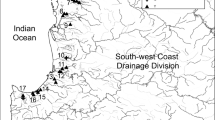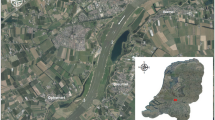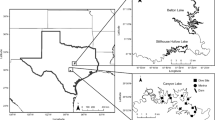Abstract
Dreissena polymorpha (zebra mussel) is a freshwater bivalve mollusc and has been present for more than one decade in Spain. The zebra mussel causes serious ecological and socioeconomic impacts in areas where they settle. Our research aims to analyze its hydraulic habitat, developing physical models for this species, which indicates its preference and optimal microhabitat requirements. To get it, a survey was completed in a lotic reach in the lower Ebro River (Tarragona, Spain). Habitat suitability curves for the variables include water velocity, depth, Froude number, velocity/depth ratio, shear stress and shear stress ratio (RSS). In addition, interactive effects between hydraulic parameters on habitat selection and its use were studied and bivariate habitat models were developed. A close relationship was observed between the D. polymorpha presence and mean flow velocity combined with depth, Froude number and RSS. Suitable habitat requirements for Dreissena were detected in areas with stable river beds under high flows, and velocity below 1.2 m/s with a depth of less than 5 m under regular flows. Information about zebra mussel preferences may enhance the design of monitoring programmes and the integrated control management of this invasive mussel.





Similar content being viewed by others
References
Ackerman, J. D., 1999. The effect of velocity on the filter feeding of zebra mussels (Dreissena polymorpha and D. bugensis): implications for trophic dynamics. Canadian Journal of Fisheries and Aquatic Sciences 56: 1551–1561.
Allen, D. C. & C. C. Vaugh, 2010. Complex hydraulic and substrate variables limit freshwater mussel species richness and abundance. Journal of North American Benthological Society 29: 383–394.
Batalla, R. J., D. Vericat & A. Palau, 2008. Efectos de las presas en la dinámica geomorfológica del tramo bajo del Ebro. Crecidas controladas. Ingeniería del Agua 15: 243–255.
Bidwell, J. R., 2010. Range expansion of Dreissena polymorpha: a review of major dispersal vectors in Europe and North America, Chap. 6. In Van der Velde, G., S. Rajagopal & A. Bij de Vaate (eds), The Zebra Mussel in Europe. Backhuys Publishers, Leiden/Margraf Publishers, Weikersheim: 69–70.
Bovee, K. D., B. L. Lamb, J. M. Bartholow, C. B. Stalnaker, J. Taylor & J. Henriksen, 1998. Stream Habitat Analysis Using the Instream Flow Incremental Methodology. U.S. Geological Survey, Biological Resources Division Information and Technology Report USGS/BRD-98/04, Fort Collins: 131 pp.
Carlton, J. T., 2008. The zebra mussel Dreissena polymorpha found in North America 1986 and 1987. Journal of Great Lakes Research 34: 770–773.
Casagrandi, R., L. Mari & M. Gatto, 2007. Modelling the local dynamics of the zebra mussel (Dreissena polymorpha). Freshwater Biology 52: 1223–1238.
Claudie, R. & G. L. Mackie, 1994. Practical Manual for Zebra Mussel Monitoring and Control. Lewis Publishers, London: 227 pp.
Daraio, J. A., L. J. Weber, S. J. Zigler, T. J. Newton & J. M. Nestler, 2012. Simulated effects of host fish distribution on juvenile unionid mussel dispersal in a large river. River Research and Applications 28(5): 594–608.
Durán, C., M. Lanao, A. Anadón & V. Touyá, 2010. Management strategies for the zebra mussel invasion in the Ebro River basin. Aquatic Invasions 5: 309–316.
Gangloff, M. M. & J. W. Femeniella, 2007. Stream channel geomorphology influences mussel abundance in southern Appalachian streams, U.S.A. Freshwater Biology 52: 64–74.
Gergs, R. & K. O. Rothhaupt, 2008. Effects of zebra mussels on a native amphipod and the invasive Dikerogammarus villosus: the influence of biodeposition and structural complexity. Journal of the North American Benthological Society 27(3): 541–548.
Gore, J. A., J. B. Layzer & J. Mead, 2001. Macroinvertebrate instream flow studies after 20 years: a role in stream management and restoration. Regulated Rivers: Research & Management 17: 527–542.
Hallstan, S., U. Grandin & W. Goedkoop, 2010. Current and modeled potential distribution of the zebra mussel (Dreissena polymorpha) in Sweden. Biological Invasions 12: 285–296.
Hardison, B. S. & J. B. Layzer, 2001. Relations between complex hydraulics and the localized distribution of mussels in three regulated rivers. Regulated Rivers: Research & Management 17: 77–84.
Hastie, L. C., P. J. Boon & M. R. Young, 2000. Physical microhabitat requirements of freshwater pearl mussels, Margaritifera margaritifera (L.). Hydrobiologia 429: 59–71.
Hebert, P. D. N., B. W. Muncaster & G. L. Mackie, 1989. Ecological and genetic studies on Dreissena polymorpha (Pallas): a new mollusc in the Great Lakes. Canadian Journal of Fisheries and Aquatic Sciences 46: 1587–1591.
Horvath, T. G. & L. Crane, 2010. Hydrodynamic forces affect larval zebra mussel (Dreissena polymorpha) mortality in a laboratory setting. Aquatic Invasions 5(4): 379–385.
Howard, J. K. & K. M. Cuffey, 2003. Freshwater mussels in a California North Coast Range river: occurrence, distribution, and controls. Journal of the North American Benthological Society 22: 63–77.
Karatayev, A. Y., D. K. Padilla, D. Minchin, D. Boltovskoy & L. E. Burlakova, 2006. Changes in global economies and trade: the potential spread of exotic freshwater. Biological Invasions 9: 161–180.
MAGRAMA, 2012. Ministerio de Agricultura, Alimentación y Medio Ambiente. Catálogo español de Especies Exóticas Invasoras, Dreissena polymorpha. Madrid: 9 pp.
Morales, Y., L. J. Weber, A. E. Mynett & T. J. Newton, 2006. Effects of substrate and hydrodynamic conditions on the formation of mussel beds in a large river. Journal of North American Benthological Society 25: 664–676.
Naddafi, R., T. Blenckner, P. Eklöv & K. Pettersson, 2011. Physical and chemical properties determine zebra mussel invasion success in lakes. Hydrobiologia 669: 227–236.
Navarro, E., M. Bacardit, L. Caputo, T. Palau & J. Armengol, 2006. Limnological characterization and flow patterns of a three-coupled reservoir system and their influence on Dreissena polymorpha populations and settlement during the stratification period. Lake and Reservoir Management 22: 293–302.
O’Neill, C. R., 1996. The zebra mussel: impacts and control. New York Sea Grant. Cornell University. State University of New York. Cornell Cooperative Extension, Information Bulletin 328: 1–62.
Oscoz, J., P. Tomás & C. Durán, 2010. Review and new records of non-indigenous freshwater invertebrates in the Ebro River basin (northeast Spain). Aquatic Invasions 5: 263–284.
Palau, A., I. Cía., D. Fargas., M. Bardina, & S. Massuti, 2004. Resultados preliminares sobre ecología básica y distribución del mejillón cebra en el embalse de Riba – Roja (río Ebro). Monografía de ENDESA, Lérida: 43 pp.
Palau, A. & I. Cía, 2006. Métodos de control y erradicación del mejillón cebra (Dreissena polymorpha). Monografía de ENDESA, Lérida: 71 pp.
Palau Ibars A., I. Cia Abaurre, R. Casas Mulet & E. Rosico Ramón, 2010. Zebra mussel distribution and habitat preference at the Ebro basin (north east Spain), Chap. 10. In Van der Velde, G., S. Rajagopal & A. Bij de Vaate (eds), The Zebra Mussel in Europe. Backhuys Publishers, Leiden/Margraf Publishers, Weikersheim: 113–118.
Parasiewicz P. & M. J. Dunbar, 2001. Physical habitat modelling for fish – a developing approach. Archiv für Hydrobiologie 135/2–4: 239–268 (Suppl. Large Rivers Vol. 12).
Parasiewicz, P., E. Castelli, J. N. Rogers & E. Plunkett, 2012. Multiplex modeling of physical habitat for endangered freshwater mussels. Ecological Modelling 228: 66–75.
Rajagopal, S., B. J. A. Pollux, J. L. Peters, G. Cremers, S. Moon-van der Staay, T. Van Alen, J. Eygensteyn, A. Van Hoek, A. Palau, A. Bij de Vaate & G. Van der Velde, 2009. Origin of Spanish invasion by the zebra mussel, Dreissena polymorpha (Pallas, 1771) revealed by amplified fragment length polymorphism (AFLP) fingerprinting. Biological Invasions 11: 2147–2159.
Shields, A., 1936. Änwendung der Aenlichkeitsmechanik und der Turbulenzforschung auf die Geschiebebewegung. Mitteilungen der Prevssische Versuchsanstalt für Wasserbau und Schiffbau, 26th ed. Heft, Berlin: 43 pp. (in German).
Steffler, P. & J. Blackburn, 2002. Two-Dimensional Depth Averaged Model of River Hydrodinamics and Fish Habitat. Introduction to Depth Averaged Modeling and User’s Manual. University of Alberta, Alberta: 119 pp.
Steuer, J. J., T. J. Newton & S. J. Zigler, 2008. Use of complex hydraulic variables to predict the distribution and density of unionids in a side cannel of the upper Mississippi River. Hydrobiologia 610: 67–82.
Strayer, D. L., 1999. Use of flow refuges by unionid mussels in rivers. Journal of the North American Benthological Society 18: 468–476.
Strayer, D. L. & H. M. Malcom, 2006. Long-term demography of a zebra mussel (Dreissena polymorpha) population. Freshwater Biology 51: 117–130.
Therriault, T. W. & M. I. Orlova, 2010. Invasion success within the familiy Dreissenidae: prerequisites, mechanisms and perspectives, Chap. 5. In Van der Velde, G., S. Rajagopal & A. Bij de Vaate (eds), The Zebra Mussel in Europe. Backhuys Publishers, Leiden/Margraf Publishers, Weikersheim: 59–68.
Vericat, D., R. Batalla & A. Palau, 2007. Análisis batimétrico del tramo bajo del río Ebro. Grupo de Geomorfologia Fluvial de la Universidad de Lleida – Centro Tecnológico Forestal de Catalunya. ENDESA Technical Report: 46 pp.
Zigler, S. T., T. J. Newton, J. J. Steuer, M. R. Bartsch & J. S. Sauer, 2008. Importance of physical and hydraulic characteristics to unionid mussels: a retrospective analysis in a reach of large river. Hydrobiologia 598: 343–360.
Acknowledgments
This research has been supported by the project No. 010/SGTB/2007/1.1: ‘Hydraulic management of reservoirs applied to the zebra mussel control’ and by the ‘Biodiversity Conservation Program’ of ENDESA. The zebra mussel sampling was carried out by the Subaquatic Activities Special Group (Guardia Civil corps). Nines Marín and Luis Adel (ENDESA) coordinated the field sampling and Damià Vericat (FSCC) provided us with the information relating to the bathymetry. We specifically thank Juan Francisco Fuentes Pérez (GEA-ecohidraulica) for his help with the illustrations.
Author information
Authors and Affiliations
Corresponding author
Additional information
Guest editors: Manuel P. M. Lopes-Lima, Ronaldo G. Sousa, Simone G. P. Varandas, Elsa M. B. Froufe & Amílcar A. T. Teixeira / Biology and Conservation of Freshwater Bivalves
Rights and permissions
About this article
Cite this article
Sanz-Ronda, F.J., López-Sáenz, S., San-Martín, R. et al. Physical habitat of zebra mussel (Dreissena polymorpha) in the lower Ebro River (Northeastern Spain): influence of hydraulic parameters in their distribution. Hydrobiologia 735, 137–147 (2014). https://doi.org/10.1007/s10750-013-1638-y
Received:
Accepted:
Published:
Issue Date:
DOI: https://doi.org/10.1007/s10750-013-1638-y




